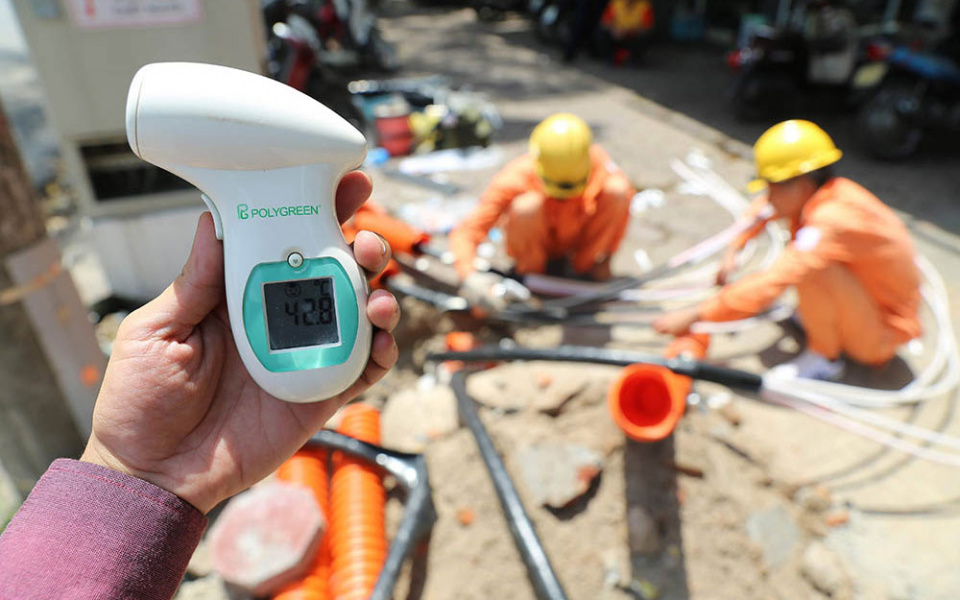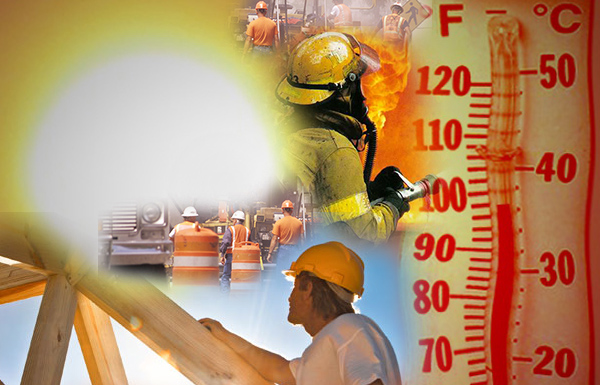
Is heat stress a concern in your workplace?
- Has anyone been affected by heat in your workplace?
- Are fans needed to keep workers cool?
- Is work done in direct sunlight?
- Are there heat-producing processes or equipment in the workplace?
- Do workers wear extra clothing/protective equipment that can make them hot (e.g., overalls, respirators, hard hats, etc.)?
- Have workers ever expressed concern about heat in the workplace?
Chances are that you answered “yes” to at least one of these questions. Actually, heat stress is something most workplaces must deal with — not just those with workers working in the hot sun or beside hot furnaces or machinery.
The purpose of this heat stress tool kit is to provide workplace parties with strategies for: recognizing the symptoms assessing the risk putting together an effective control program
Heat stress can harm or even kill people working under very hot conditions.
To help employers and workers learn how to prevent heat stress, this guide summarizes the causes, symptoms, and treatment of heat-related illness presents a five-step approach for using the Humidex to assess heat stress hazards outlines specific actions for managing and controlling heat stress
What is Heat Stress?
Heat stress is the body’s inability to control its internal temperature. It can result in serious illness or death.
The disorders and their symptoms of heat stress:
Heat Rashes: These are a common problem resulting from persistent wetting of clothing by un-evaporated sweat.
- Symptoms: Clusters of small red dots or pimples and itchy skin
- First Aid Treatment: If possible allow the area to get dry, cool air, use a drying agent like talc or baby powder.
Heat Cramps: These are usually the result of hard physical labour in a hot environment, often resulting from an imbalance of electrolytes in the body.
- Symptoms: Headaches, dizziness, vomiting or upset stomach
- First Aid Treatment: Remove patient from hot environment, rest/massage cramping muscles, replace fluids by water.
Heat Exhaustion: This is a result of the combination of excessive heat and dehydration.
Untreated, heat exhaustion can lead to heat stroke.
- Symptoms: Moist skin, rapid weak pulse, feeling tired or weak, and muscle cramps
- First Aid Treatment: Have the person rest in a cool place, give cool water, remove excess clothing, apply cool wet cloths and fan.
Heat Stroke: This is the most serious disorder associated with heat stress. It occurs when the body’s temperature regulation fails, and body temperature rises to critical levels. It is a medical emergency that could lead to death.
- Symptoms: Unable to sweat, hot dry red skin, rapid and weak pulse, mental confusion, unconsciousness, seizures, and convulsions.
- First Aid Treatment: THIS IS A LIFE-THREATENING EMERGENCY! SEEK MEDICAL ATTENTION IMMEDIATELY! Cool body by any means available – cold packs, wrap in sheet and soak with water, Monitor ABC’s (airway, breathing, circulation), be prepared to perform CPR.

How does Heat Stress effect workers?
Sweat evaporates more rapidly in dry weather, cooling the body more efficiently than in humid weather. When working in humid conditions, the core temperature rises more rapidly. This is why weather forecasts add a humidity heat factor to represent how you will actually feel outdoors.
There are two humidex guidelines to determine the appropriate actions required:
Humidex 1 – refers to un-acclimatized workers doing moderate work, and ranges indicate the need for general heat stress controls.
- Humidex 1 general controls – include providing annual heat stress training, encouraging adequate fluid replacement, permitting self-limitation of exposure, encouraging employees to watch for symptoms in co-workers, and adjusting expectations for workers coming back to work after an absence.
Humidex 2 – refers to acclimatized workers doing moderate work, and ranges indicate the need for specific controls.
- Humidex 2 specific controls – include (in addition to general controls) engineering controls to reduce physical job demands, shielding of radiant heat, increased air movement, reduction of heat and moisture emissions at the source, adjusting exposure times to allow sufficient recovery, and personal body-cooling equipment.

Did You Know? Heat stress is progressive; therefore, it is important to recognize the signs and symptoms before they occur.

Ways you can reduce the risk of heat stress.
Work in a cooler workspace
- Using ventilation or air-conditioning to reduce temperatures and humidity in work and rest areas
- Work in shaded areas and if possible and away or shielded from heat sources
Reduce your exposure to heat stress
- Monitor yourself and co-workers for signs and symptoms of heat illness
- Acclimatization – begin by exposing yourself in short durations at the beginning of the season and then slowly increasing your exposure and duration; this will build up tolerance
- Use work-rest cycles, with breaks and rests taking part in cool, shaded areas that are well ventilated
- Take more frequent rest breaks; take longer rest breaks
- Slow the work pace (i.e. work self-pacing)
- Minimize hard, physical labour for the coolest parts of the day
- Drink plenty of water throughout the work day, and before exposure; Water or sport drinks are best; Avoid caffeinated beverages and alcohol
- If possible rotate hot work duties with co-workers; Under extreme conditions, work must be stopped
Adjust your clothing according to the environment
- Wear lightweight, light-coloured, loose fitting clothing
- Dress in layers so clothing can be removed as the temperature rises
- Wear a hat and sunscreen when working in direct sunlight
- Wear heat reflective clothing if working near heat sources
Is there a magic number for the temperature that you can’t work at?
The short answer is no. There are just more questions such as:
- The individual doing the work, what is their health like?
- What are the demands of the work?
- When does the work have to be done?
- What is the humidex?
- Is it under direct sun or indoors?
- Is there a breeze or is the air still?
- Most important of all, listen to the signals that the body is giving! What signals are the body giving?
Take into consideration the work that has to be done, who is doing it and apply the information here to make safe choices. If the humidex is over 42 or 47 and you follow the work / rest schedule on the humidex table, at 45 minutes per hour rest, 15 minutes work, there might not be a business case to keep working.
With summer temperatures rising, working in extreme heat can pose a serious threat to your team. We want EVERYONE to stay safe, healthy, and comfortable this summer and have provided these 3 FREE Resources to help make sure you’re business is prepared so you can quickly implement preventative measures as needed:
- When Heat Turns Deadly” Hazard Alert
Key steps and resources to discuss with your team to prevent a Heat Emergency.
- Heat Stress – Safe Work Practice
Just customize to your workplace and you’ll be ready to implement in a jiffy!
- Heat Stress Safety Talk
Use the talking points to educate your employees on how to recognize a deadly heat emergency and stay cool this summer
Do you need help with your summer safety plans?
Questions about your workplace safety risk management?
Contact 1Life Workplace Safety Solutions for a no obligation consultation at 204-231-5433.




